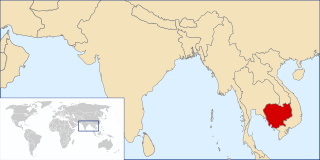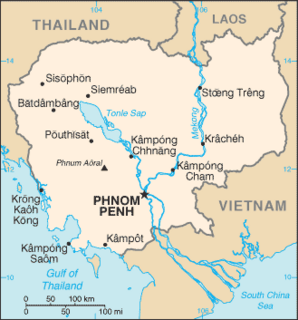| UN Security Council Resolution 728 | |
|---|---|
 Land mine victim in Cambodia | |
| Date | 8 January 1992 |
| Meeting no. | 3,029 |
| Code | S/RES/728 (Document) |
| Subject | The situation in Cambodia |
Voting summary | 15 voted for None voted against None abstained |
| Result | Adopted |
| Security Council composition | |
Permanent members | |
Non-permanent members | |
United Nations Security Council resolution 728, adopted unanimously on 8 January 1992, after recalling resolutions 668 (1990), 717 (1991) and 718 (1991), the Council welcomed the implementation by all parties of the agreement in Paris on 23 October 1991, but expressed concern at the existence of land mines in Cambodia.

United Nations Security Council resolution 668, adopted unanimously on 20 September 1990, after noting the ongoing political discussions and efforts regarding a just and lasting peaceful situation in Cambodia, the Council endorsed the political framework that would enable the Cambodian people to exercise their right to self-determination through U.N. organised elections.

United Nations Security Council resolution 717, adopted unanimously on 16 October 1991, after noting a report by the Secretary-General Javier Pérez de Cuéllar and reaffirming Resolution 668 (1990), the Council decided to establish the United Nations Advance Mission in Cambodia (UNAMIC) immediately after the signing of agreements for a political settlement in Cambodia.

United Nations Security Council resolution 718, adopted unanimously on 31 October 1991, after recalling resolutions 668 (1990) and 717 (1991), and noting that at the Paris Conference, a political agreement was signed by parties to the situation in Cambodia, the Council authorised the Secretary-General to submit a report on the costs for the United Nations Transitional Authority in Cambodia, prior to its establishment.
Contents
The Council noted the establishment of a mine-awareness programme by a report of the Secretary-General in Resolution 717, and that the agreements allow the United Nations Transitional Authority in Cambodia to assist in the process of demining and to undertake training programmes. It also requested the Supreme National Council of Cambodia to co-operate with the United Nations Advance Mission in Cambodia with its expanded mandate of demining and training the local population, and again called upon all parties to observe the ceasefire. [1]

The secretary-general of the United Nations is the head of the United Nations Secretariat, one of the six principal organs of the United Nations. The secretary-general serves as the chief administrative officer of the United Nations. The role of the United Nations Secretariat, and of the secretary-general in particular, is laid out by Chapter XV of the United Nations Charter.

The United Nations Transitional Authority in Cambodia (UNTAC) was a United Nations peacekeeping operation in Cambodia in 1992–93 formed following the 1991 Paris Peace Accords. It was also the first occasion on which the UN had taken over the administration of an independent state, organised and run an election, had its own radio station and jail, and been responsible for promoting and safeguarding human rights at the national level.

Demining or mine clearance is the process of removing land mines from an area. In military operations, the object is to rapidly clear a path through a minefield, and this is often done with devices such as mine plows and blast waves. By contrast, the goal of humanitarian demining is to remove all of the landmines to a given depth and make the land safe for human use. Specially trained dogs are also used to narrow down the search and verify that an area is cleared. Mechanical devices such as flails and excavators are sometimes used to clear mines.











